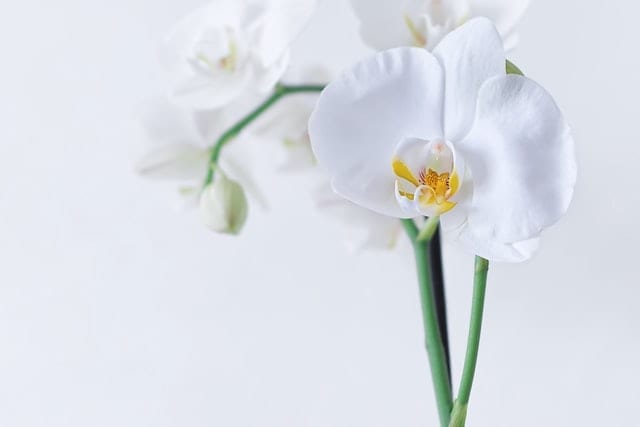Humidity can be a problem in some areas of the world, and difficult to control. It can also just be humidity from your hot shower that you’re trying to rid of naturally. There are some dehumidifying plants that can help!
*This post may include affiliate links. When you purchase items from these links, we will receive a small commission, at no extra cost to you, to help support this website. Thank you for your support! Read more ->
These plants not only thrive in the humidity, but can also help control it. One thing to note is that some other plants may increase the humidity in the room, so beware when choosing plants!
Tillandsia
Tillandsia is a great air plant to choose as a dehumidifying plant. It’s small, doesn’t require soil or even a pot, so you can have it just about anywhere in a room. It works well absorbing humidity by being placed next to a bright window that brings in direct sunlight.
The ample amount of filtered sunlight enables it to grow very well and survive. Soak this plant in water for it to continue thriving, and prevent concave leaves. It can survive without direct sunlight as well if you’re looking to put it in a different spot of the room. You can choose any room to place this air plant in since it absorbs nutrients and moisture from the surroundings through the leaves. This makes it extremely advantageous to have around your home.
Bromeliad

Bromeliads absorb humidity in a similar fashion as the Tillandsia mentioned above. They are from the same family! The main difference that differentiate these two plants is that bromeliads grow better with soil. Not only will the plant help with getting rid of humidity, but it’s also gorgeous, and it will make any room have a beautiful pop of color.
It doesn’t require a lot of effort to maintain. Despite there being several different types of bromeliads, caring for all of them is just the same. They do thrive well around high humidity and absorb moisture from the air. Bromeliads do need bright filtered light, ideally coming from a window that faces south or west.
Orchids

When it comes to orchids, there is a large variety to choose from. The best dehumidifying plants among orchids are the dendrobium and moth orchids. Not only will these reduce the humidity, but they also help clean the air of toxins, like xylene, toluene, and formaldehyde.
Orchids are very pleasing to look at, and they’ll make any indoor space look spectacular. Some orchids have distinctive smells It would be best if you were mindful when purchasing orchids because of their smell. A common feature in all orchids how much they all love high humidity and significantly absorb moisture from the air.
Orchids can be difficult to care for, so only try growing an orchid if you have patience and can remember to water this plant when needed.
English Ivy
Among plants that absorb humidity, English ivy is a great choice. It is efficient in getting rid of mold found in humid places with reducing humidity. This plant does like moist soil. Place this plant near a ceiling to absorb rising humidity.
It is also a great plant to choose if you have pets. This plant helps reduce any airborne fecal matter that might be in your home. Not only does ivy absorb fecal matter, but it also absorbs formaldehyde, an organic compound that is very common (often found in furniture and carpet treatment).
Peace Lily
Peace lilies are a very popular houseplant with it’s stunning white flowers. It helps reduce excess humidity because the plant absorbs moisture from the air through the leaves as well as the roots. It doesn’t require a lot of sunlight to flourish, making it an ideal indoor plant.
The peace lily will also clean the air, getting rid of some contaminants that are found in your indoor air as well. It removes toxins and air pollutants. This plant can be placed in the bathroom to absorb moisture, as well as alcohol, acetone, and other harmful vapors.
Keep it away from kids and pets since it can be toxic if consumed.
Boston Fern

The Boston Fern is both beautiful and beneficial to your home. This is a great choice of a dehumidifying plant to grow in any room. It grows efficiently by using moisture from the air. Not only does the Boston fern help with controlling humidity, but it also gets rid of air pollutants that are harmful to your health.
Among the harmful toxins, it helps remove formaldehyde, xylene, and benzene. This leaves your air cleaner and less humid! Place this plant in a hanging basket to reduce the need for counter space and add this plant to any room.
Spider Plant

The spider plant is a very popular houseplant for all of the benefits it creates in the environment as well as it’s stunning looks. This is another of the dehumidifying plants that reduces the moisture in the air as well as being extremely low maintenance to care for. This is yet another one of the dehumidifying plants that help with humidity and grows indoors easily.
This plant doesn’t need direct sunlight or much attention to thrive, making it the perfect plant to hang in darker areas of the house or putting on a shelf in a quiet corner. Find out which spider plant variety is best for you!
Reed Palm

The reed palm is a plant that really likes humidity and thrives in tropical areas. This is a good choice of plant to grow in a bathroom to help with the humidity, as it not only loves the steam but also the heat.
Like the other plants, the reed palm also can purify the air from any pollutants that might be in the air. It’s a great choice for a dehumidifying plant and an excellent plant for getting rid of different contaminants in your home.
Pin It!
Want to keep these plant ideas for later? Save them to Pinterest!








